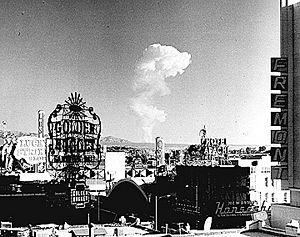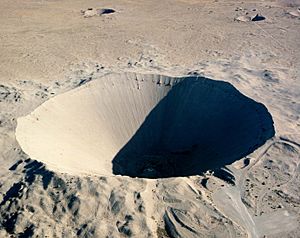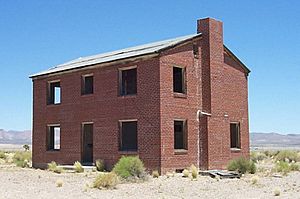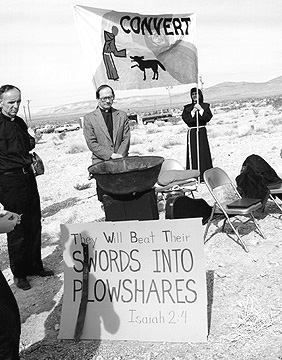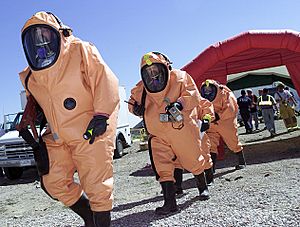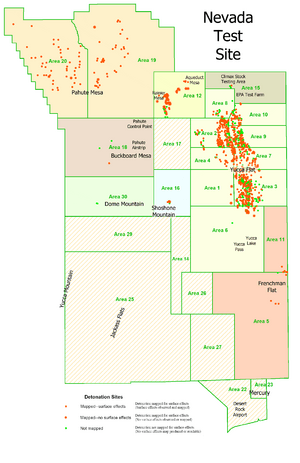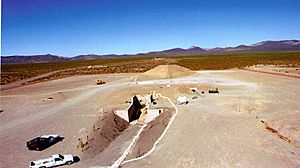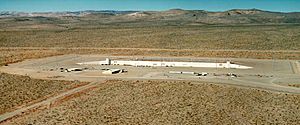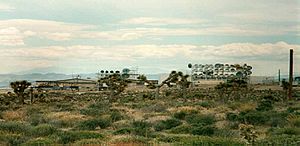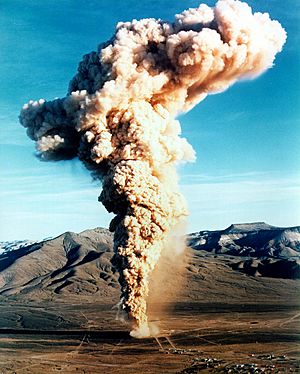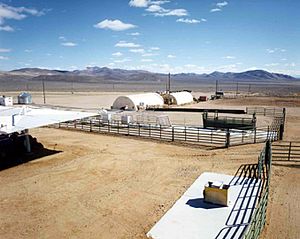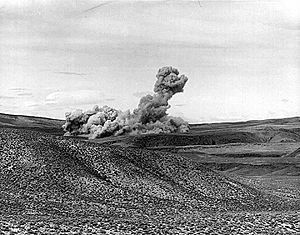Nevada Test Site facts for kids
Quick facts for kids Nevada National Security Site |
|
|---|---|
| Near Las Vegas, Nevada in the United States | |
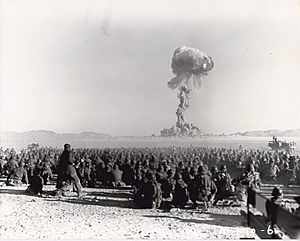
A November 1951 nuclear test at Nevada Test Site, Operation Buster–Jangle "Dog". It had a yield of 21 kilotons of TNT (88 TJ), and was the first U.S. nuclear field exercise conducted with live troops maneuvering on land. Troops shown are 6 mi (10 km) from the blast.
|
|
|
Map showing location of the site
|
|
| Coordinates | 37°07′N 116°03′W / 37.117°N 116.050°W |
| Type | Nuclear Weapons Research Complex |
| Area | ~1,350 sq mi (3,500 km2) |
| Site information | |
| Operator | United States Department of Energy |
| Status | Active |
| Site history | |
| In use | 1951–present |
| Test information | |
| Nuclear tests | 928 |
The Nevada National Security Site (N2S2 or NNSS), once known as the Nevada Test Site (NTS), is a special area run by the United States Department of Energy. It's located in southeastern Nye County, Nevada, about 65 miles (105 km) northwest of Las Vegas. This large desert and mountain area, covering about 1,360 square miles (3,500 km2), was set up in 1951.
Its main purpose was to test nuclear devices. The very first test happened on January 27, 1951, with a 1-kiloton bomb dropped on a place called Frenchman Flat. For the next 40 years, over 1,000 nuclear explosions took place here. Many famous pictures from the nuclear age come from this site.
During the 1950s, the huge mushroom clouds from the above-ground tests could be seen from almost 100 mi (160 km) away. People in Las Vegas could feel the ground shake, and the distant mushroom clouds even became a strange tourist attraction. Winds often carried the fallout from these tests over places like St. George, Utah. Sadly, some people living downwind reported health problems like certain types of cancer later on.
Most of the later tests, 921 of them, were carried out deep underground. From 1986 to 1994, many anti-nuclear protests happened at the site. Thousands of people took part, and many were arrested while speaking out against nuclear weapons testing.
Today, the site has 28 different areas, over 1,100 buildings, and hundreds of miles of roads. It also has heliports and airstrips. A company called Mission Support and Test Services (MSTS) currently manages the site for the National Nuclear Security Administration (NNSA).
Contents
- History of Nuclear Testing in Nevada
- Testing Structures and Safety
- Environmental Impact of Testing
- Protests Against Nuclear Testing
- Current Uses of the Site
- Interesting Places and Geography
- Nuclear Test Series at Nevada Test Site
- Areas of the Nevada Test Site
- Area 1: Early Tests and Training
- Area 2: Many Detonations
- Area 3: Most Nuclear Tests
- Area 4: Explosives Facility
- Area 5: First Tests and Accidents
- Area 6: Control Center and Assembly
- Area 7: Airdrop Tests
- Area 8: Baneberry Accident
- Area 9: Largest Continental US Test
- Area 10: First Underground Test and Sedan Crater
- Area 11: Plutonium Valley
- Area 12: Tunnel Tests
- Area 13: No Longer Exists
- Area 14: Outdoor Experiments
- Area 15: Underground Bunkers and EPA Farm
- Area 16: Six Nuclear Tests
- Area 17: No Nuclear Tests
- Area 18: Pahute Mesa Airstrip
- Area 19 & 20: Pahute Mesa
- Area 22: Camp Desert Rock
- Area 23: Mercury Town
- Area 25: Special Projects
- Area 26: Arid and Training Area
- Area 27: Another Test Area
- Area 28: Absorbed into Other Areas
- Area 29: Buffer Zone
- Area 30: Military Training
- Images for kids
- See also
History of Nuclear Testing in Nevada
The Nevada Test Site was created by President Harry S. Truman on December 18, 1950. It was originally part of the Nevada Test and Training Range.
Early Years of Testing (1951–1992)
The Nevada Test Site was the main place where the United States tested its nuclear weapons from 1951 to 1992. A total of 928 official nuclear tests happened here. Most of these, 828, were done underground. If you visit the site, you can still see many large holes in the ground called subsidence craters from these underground tests.
The NTS was used for medium-sized nuclear tests. Larger tests, especially those over 1,000 kt (4,200 TJ), were often done in other places like the Pacific Proving Grounds in the Marshall Islands.
In the 1950s, the giant mushroom clouds from tests done in the air were visible from nearly 100 mi (160 km) away. People in Las Vegas could feel the ground shake, and these distant clouds became a tourist sight. The last test done in the air at the Nevada Test Site was "Little Feller I" on July 17, 1962.
Even though the United States has not officially signed the Comprehensive Nuclear-Test-Ban Treaty, it follows its rules. This means that full-scale underground nuclear weapons testing stopped on September 23, 1992. However, smaller "subcritical" tests, which do not cause a nuclear explosion, still happen.
One very famous test was called "Sedan" on July 6, 1962. This test was part of a program called Operation Plowshare. The idea was to see if nuclear weapons could be used for peaceful things, like digging out bays or canals. The "Sedan" test created a huge hole, or crater, that is 1,280 feet (390 m) wide and 320 feet (100 m) deep. You can still see this crater today.
Modern Activities (1992–Present)
In 2006, there was a plan to test a very large non-nuclear bomb called Divine Strake at the site. This bomb was considered as an alternative to nuclear bunker busters. After concerns from lawmakers in Nevada and Utah, the test was canceled in 2007. The most recent test at the site was on December 7, 2012. It was an underground subcritical test to study plutonium.
Testing Structures and Safety
During the above-ground nuclear tests, the NTS also performed "piggyback" tests. This meant they placed vehicles, shelters, and buildings at different distances from where the bomb would explode.
They built model homes and businesses that looked like those in American and European cities. They also built military forts and bomb shelters. Sometimes, several buildings of the same type were built with small differences, like different paint colors or distances from the blast. Mannequins were placed inside and around these structures.
Special high-speed cameras were set up in safe places to record what happened when the bombs went off. These cameras captured amazing footage of paint boiling off buildings, structures being pushed away by the shockwave, and then being pulled back by the rising mushroom cloud. This footage is now famous and can be seen in many videos.
These tests helped scientists create guidelines for the public. These guidelines were meant to help people survive if there was a nuclear attack.
Environmental Impact of Testing
Each underground nuclear explosion created a large empty space deep in the ground. This space was filled with radioactive rubble. About one-third of these tests happened directly in underground water sources called aquifers. Others were hundreds or thousands of feet below the water table.
When underground explosions stopped in 1992, the Department of Energy estimated that a huge amount of radioactivity was left in the environment. This made the site one of the most radioactively contaminated places in the United States. In some areas, the amount of radioactivity in the groundwater is millions of times higher than what is considered safe for drinking water.
Even though radioactivity levels in the water are slowly going down, some long-lasting radioactive materials like plutonium or uranium could be a risk for tens of thousands of years. The Energy Department has monitoring wells to check the water. Because the contaminated water doesn't pose an immediate health threat, cleaning up the Nevada site is not the highest priority compared to other nuclear weapons sites.
Protests Against Nuclear Testing
From 1986 to 1994, many protests happened at the Nevada Test Site. During this time, 536 demonstrations took place, with 37,488 people participating. Government records show that 15,740 arrests were made during these protests.
On February 5, 1987, over 400 people were arrested when they tried to enter the site. This happened after nearly 2,000 demonstrators held a rally to protest nuclear weapons testing. Famous people like astronomer Carl Sagan and actors Kris Kristofferson, Martin Sheen, and Robert Blake were among those arrested. Several members of Congress also attended the rally.
Groups like American Peace Test (APT) and Nevada Desert Experience (NDE) organized most of these protests. In March 1988, APT held a large event where over 8,000 people took part in a ten-day action. Nearly 3,000 people were arrested during this event, with more than 1,200 arrests in a single day. This set a record for the most arrests in one protest.
After 1994, other groups like Shundahai Network continued to protest the government's nuclear weapons work. They also tried to stop a plan to store highly radioactive waste at Yucca Mountain, which is about 100 mi (160 km) northwest of Las Vegas.
Current Uses of the Site
The test site offers public tours every month, but they are often fully booked far in advance. Visitors are not allowed to bring cameras, binoculars, or cell phones. They also cannot pick up rocks as souvenirs.
While there are no more explosive nuclear weapons tests, smaller "subcritical" tests are still done. These tests help scientists understand if the United States' older nuclear weapons are still working properly. The site also has the Area 5 Radioactive Waste Management Complex. This facility sorts and stores low-level radioactive waste that doesn't stay dangerous for too long.
The site is also used for training. For example, there's a special area called the Radiological/Nuclear WMD Incident Exercise Site (T-1). It looks like a place where a terrorist radiological incident might happen, with props like trains, planes, cars, trucks, and helicopters. This helps train emergency responders.
Interesting Places and Geography
The NNSS has many interesting places. Here are some of them:
| Name | Location | Notes |
|---|---|---|
| Mercury | Area 23 36°39′34″N 115°59′47″W / 36.6594°N 115.99642°W | This is the main base area with housing and offices for people working at the NTS. |
| U1a | Area 1 37°00′29″N 116°03′32″W / 37.00819°N 116.05894°W | The U1a Complex is an underground lab. It's used for subcritical experiments, which help scientists learn about US nuclear weapons without causing an explosion. |
| Doomtown | Area 5 36°47′53″N 115°56′03″W / 36.79805°N 115.93416°W | This was an original test area where they studied how nuclear blasts affected buildings. It's similar to Survival City in Area 1. |
| EPA's NTS Dairy | Area 15 37°12′30″N 116°02′25″W / 37.20829°N 116.04037°W | From 1964 to 1984, the EPA ran a dairy and pig farm here. They studied how radioactive materials were taken up by milk and food. |
| Yucca Mountain nuclear waste repository | Area 25 36°51′10″N 116°25′36″W / 36.85282°N 116.42672°W | This is a proposed site for storing highly radioactive waste deep underground. |
| Sedan Crater | Area 10 37°10′55″N 116°03′29″W / 37.182°N 116.058°W | A huge crater created by the "Sedan" nuclear test in 1962, part of the "Plowshare" program. |
| Plutonium Valley | Area 11 36°58′36″N 115°57′44″W / 36.97659°N 115.96228°W | This area has scattered plutonium from safety tests. |
| BREN Tower | Area 25 36°46′50″N 116°14′37″W / 36.78062°N 116.24358°W | A very tall tower (453 m (1,486 ft)) used to study the effects of radiation. It was taken down in 2012. |
| DAF | Area 6 36°53′54″N 116°02′53″W / 36.89827°N 116.04814°W | Device Assembly Facility: This is where parts of bombs and other devices were put together for testing. |
| RWMS-5 | Area 5 36°51′27″N 115°57′18″W / 36.85758°N 115.9551°W | Radioactive Waste Management Facility, Area 5. This is where radioactive waste is handled. |
| Apple-2 houses | Area 1 37°02′40″N 116°04′26″W / 37.04434°N 116.07397°W | Three model houses built for a civil defense test called Apple-2. You can still see them today. |
| News Nob | Area 6 36°56′42″N 116°03′00″W / 36.945°N 116.05°W | This was the spot where important people and news reporters would watch the nuclear tests. |
| Groom Lake - Area 51 | Area 51 37°14′23″N 115°48′49″W / 37.23986°N 115.81363°W | The famous Air Force base known for testing secret aircraft. |
| Camp Desert Rock | Area 22 36°37′33″N 116°01′10″W / 36.62593°N 116.01937°W | An Army camp that housed soldiers who were training during atmospheric nuclear tests. |
| Test Control Point | Area 6 36°56′04″N 116°03′17″W / 36.93453°N 116.05482°W | This was the main control center for the NTS. It was used to start and watch the nuclear test explosions. |
| Super Kukla | Area 27 36°46′45″N 116°06′37″W / 36.77907°N 116.11041°W | A special test area used from 1965 to 1978 to test equipment in a radioactive environment. |
| The Forest | Area 5 36°45′33″N 115°57′05″W / 36.75907°N 115.95138°W | A famous group of trees in the desert that were hit by the blasts of the Encore and Grable tests. |
Nuclear Test Series at Nevada Test Site
Many different series of nuclear tests were carried out at the Nevada Test Site. Each series had its own name and specific goals. Here are some of them:
Areas of the Nevada Test Site
The Nevada Test Site is divided into many different areas. Each area has its own history and uses.
Area 1: Early Tests and Training
Area 1 was the location for 8 nuclear tests, with a total of 9 explosions. Four early tests were done in the air above Area 1 in the early 1950s. Three underground tests also happened here later. In 1955, an experiment called Operation Cue studied how nuclear blasts affected different types of buildings. Some of these structures are still standing today.
Today, Area 1 has heavy drilling equipment and concrete building facilities. Non-destructive tests, like X-ray and gamma ray tests, are still done here. The radioactivity in Area 1 also makes it a good place to train first responders to deal with contaminated environments.
Area 2: Many Detonations
Area 2 is in the Mojave Desert and is about 18 miles southwest of Area 51. This area was the site of 144 tests, which included 169 explosions. One planned test called "Gabbs" was left in place when testing stopped.
Area 3: Most Nuclear Tests
Area 3 had the most nuclear tests of any area at the NTS, with 266 tests and 288 explosions. On June 24, 1980, a small satellite prototype was exposed to radiation from a test called "Huron King" in Area 3. This was part of a program to make defense satellites stronger against nuclear effects.
The very last nuclear test explosion at the Nevada Test Site was "Divider" on September 23, 1992. This test happened just before all nuclear testing was temporarily stopped. "Divider" was a safety experiment that was set off at the bottom of a deep shaft in Area 3.
Area 4: Explosives Facility
Area 4 was used for 40 nuclear tests, with a total of 44 explosions. It is now home to the Big Explosives Experimental Facility (BEEF).
Area 5: First Tests and Accidents
Area 5 was the site of 19 nuclear tests. The very first nuclear tests at the NTS, part of Operation Ranger, started in Area 5 on January 27, 1951. Other tests were done here, including the Grable shot, which was fired from a large cannon in Area 11 and exploded in Area 5. The Priscilla test also happened here on June 24, 1957.
Five underground tests were set up in Area 5, and four of them accidentally released radioactive materials. On March 16, 1968, scientist Glenn Seaborg visited the site of an upcoming test called Milk Shake. The radioactive release from Milk Shake was not detected outside the NTS.
Area 6: Control Center and Assembly
Area 6 had 4 nuclear tests, with a total of 6 explosions. Two towns, BJ Wye and Mule Lick, existed in Yucca Flats within Area 6 before 1947. The area has an asphalt runway and some buildings, including a hangar.
The Device Assembly Facility (DAF) was built to put together nuclear explosives. Now, it is used as the Criticality Experiments Facility (CEF). The Control Point in Area 6 was the main communication center for the NTS. Controllers used it to start and watch the nuclear test explosions.
Area 7: Airdrop Tests
Area 7 was the location for 92 nuclear tests. During Operation Buster, four successful tests were done by dropping nuclear weapons from bomber aircraft over Area 7.
A planned test called "Icecap" was left in Area 7 when testing stopped in 1992. The tower, shaft, and wiring are still there, along with a crane that was meant to lower the nuclear test package.
Area 8: Baneberry Accident
Area 8 held 13 nuclear tests, with a total of 15 explosions. Area 8 was where the "Baneberry" test happened on December 18, 1970. This 10 kt (42 TJ) test exploded 900 feet (270 m) underground. However, it cracked the soil in unexpected ways, causing a crack near the explosion site. This released a cloud of fire and dust, spreading radioactive fallout over workers in different parts of the NTS.
Area 9: Largest Continental US Test
Area 9 had 115 nuclear tests, with a total of 133 explosions. In Area 9, the "Hood" test on July 5, 1957, was the largest test ever done in the air within the United States. It was almost five times more powerful than the bomb dropped on Hiroshima. A balloon carried the "Hood" bomb 460 meters above the ground before it exploded. Over 2,000 soldiers took part in this test to train for operations on a nuclear battlefield.
Area 10: First Underground Test and Sedan Crater
Area 10 held 57 nuclear tests, with a total of 71 explosions. The very first underground test at the NTS was the "Uncle" shot. It exploded on November 29, 1951, inside a shaft dug in Area 10.
The "John" shot on July 19, 1957, was the first test of a nuclear-tipped rocket called the AIR-2 Genie. This rocket was designed to destroy enemy bombers. The 2 kt (8.4 TJ) warhead exploded about three miles above five volunteers and a photographer. They stood unprotected on the ground in Area 10 to show that battlefield nuclear weapons were supposedly safe for ground personnel.
The famous "Sedan" test also happened in Area 10 on July 6, 1962. This test was part of Operation Plowshare, which explored using nuclear weapons for peaceful purposes like creating lakes or canals. The explosion moved twelve million tons of earth, creating the huge Sedan crater that is 1,280 feet (390 m) wide and 320 feet (100 m) deep.
Area 11: Plutonium Valley
Area 11 had 9 nuclear tests. Four of these were weapons safety experiments that spread a lot of harmful radioactive material around the test sites. Because of this, Area 11 has been called "Plutonium Valley." The radiation levels here make Area 11 a good place for realistic training in how to detect radiation.
Area 12: Tunnel Tests
Area 12 was the site of 61 nuclear tests between 1957 and 1992. All of these tests were done deep underground in tunnels dug into Rainier and Aqueduct mesas. Area 12 was mainly used for these tunnel tests.
Area 13: No Longer Exists
There is no Area 13 within the NNSS itself. However, a part of the Nevada Test and Training Range next to Area 15 is sometimes called Area 13. A weapons safety test was done here on April 24, 1957, which spread radioactive particles over a large area.
Area 14: Outdoor Experiments
Area 14 covers about 26 square miles (67 km2) in the middle of the NNSS. Various outdoor experiments are conducted here. No nuclear tests, either in the air or underground, were ever done in Area 14.
Area 15: Underground Bunkers and EPA Farm
Three underground nuclear tests took place in Area 15 in the 1960s. One important test was Pile Driver, which was a Department of Defense test. A huge underground structure was built to see how well hardened underground bunkers could survive a nuclear attack. The information from this test helped design strong missile silos and the North American Aerospace Defense Command (NORAD) facility in Colorado Springs.
The abandoned Crystal and Climax mines are in Area 15. Storage tanks here hold contaminated materials. From 1964 to 1981, the Environmental Protection Agency (EPA) ran a 36-acre (150,000 m2) experimental farm in Area 15. Scientists studied how pollutants were taken up by farm vegetables and by dairy cows, horses, pigs, goats, and chickens.
Area 16: Six Nuclear Tests
Area 16 was the location for 6 nuclear tests.
Area 17: No Nuclear Tests
No nuclear tests took place in Area 17.
Area 18: Pahute Mesa Airstrip
Area 18 had 5 nuclear tests and includes the Pahute Mesa Airstrip.
Area 19 & 20: Pahute Mesa
Pahute Mesa is one of the four main nuclear test regions within the Nevada National Security Site. It covers 243 square miles (630 km2) in the northwest part of the NNSS. The eastern part is called Area 19, and the western part is Area 20. A total of 85 nuclear tests were done in Pahute Mesa between 1965 and 1992. Three of these tests were very powerful, with a yield of over one megaton.
Area 22: Camp Desert Rock
No nuclear tests happened in Area 22. Area 22 was once home to Camp Desert Rock, which was a base for soldiers training during atmospheric nuclear blasts. In 1955, as many as 9,000 soldiers were camped there. The runway at Desert Rock Airport was made longer in 1969. It is now used to transport people and supplies to the NNSS and as an emergency landing strip.
Area 23: Mercury Town
No nuclear tests took place in Area 23. The town of Mercury, Nevada is located within Area 23. This area is the main way to get to and from the NNSS test locations. Mercury is also the main management area for the site, with offices, a cafeteria, medical center, and other facilities for workers. In its busiest times in the 1950s and '60s, it even had restaurants, a bowling alley, and a movie theater.
Area 25: Special Projects
Area 25 was used for various special projects, including testing nuclear rockets.
Area 26: Arid and Training Area
No nuclear tests happened in Area 26, which is the driest part of the NNSS. An old abandoned mine here was used for waste disposal. In 1983, the Department of Defense, the Department of Energy, and the Federal Emergency Management Agency did tests here. They simulated a nuclear-armed helicopter explosion and the spread of nuclear debris.
An eight-square-mile complex was built in Area 26 to support Project Pluto, which was about developing a nuclear-powered cruise missile engine. These buildings are now used to train first responders as mock reactor facilities.
Area 27: Another Test Area
Area 27 was also a location for nuclear tests.
Area 28: Absorbed into Other Areas
Area 28 no longer exists. It was combined into Areas 25 and 27.
Area 29: Buffer Zone
No nuclear tests took place in Area 29. This area has rough terrain and acts as a buffer zone between other parts of the NNSS. There is a helipad at Shoshone Peak.
Area 30: Military Training
Area 30 covers about 59 square miles (150 km2) at the western edge of the NNSS. It has rugged terrain and is mainly used for military training and exercises. Area 30 was the site of one nuclear test, the Crosstie Buggy experiment, which involved 5 explosions at the same time.
Images for kids
-
A map that details the federal land in southern Nevada, showing the site
-
I-131 Fallout Exposure in rads
See also
 In Spanish: Emplazamiento de pruebas de Nevada para niños
In Spanish: Emplazamiento de pruebas de Nevada para niños



